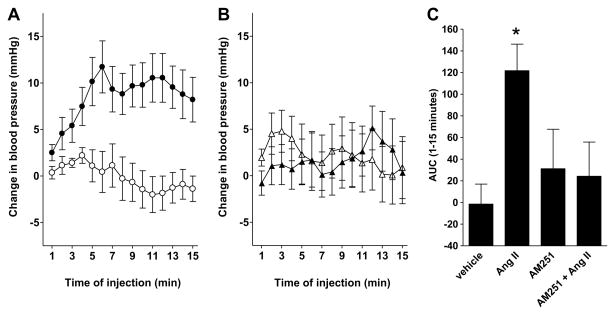Fig. 2.
CB1R plays a role in the hypertensive effects of angiotensin II in the rat paraventricular nucleus. AM251 (150 ng/rat, Biozol) and angiotensin II (500 ng/rat, Sigma) and/or vehicle were administered through a cannula inserted into a previously implanted guide cannula into the paraventricular nucleus of the hypothalamus (PVN) in a single 10 min microinfusion in urethane anaesthetized male Wistar rats. Mean arterial pressure (MAP) was measured from the left femoral artery. Surgery, localization of the PVN and verification of the site of injection were performed as described previously (Bagdy, 1996; Bagdy and Makara, 1994; To and Bagdy, 1999). (A) Grouped data showing the changes from baseline in the MAP of animals treated by vehicle (open circles) or Ang II (closed circles). (B) Grouped data showing the changes from baseline in the MAP of animals treated by AM251 (open triangles) or Ang II + AM251 (closed triangles). (C) Area under the curve (AUC) was determined for MAP changes over a 15-min period from the beginning of the treatment. Statistical analysis (two-way ANOVA followed by Tukey's post hoc test) showed significant differences between AUC values of AngII- and AngII + AM251-treated animals (*p < 0.05 compared to vehicle treatment). All data are mean ± SEM, n = 3. All animal experiments were carried out in accordance with the European Communities Council Directive of 24 November 1986 (86/609/EEC) and the National Institutes of Health “Principles of Laboratory Animal Care” (NIH Publications No. 85-23, revised 1985), as well as specific national laws (the Hungarian Governmental Regulations on animal studies, December 31, 1998). Permission was obtained from the local ethical committees.

